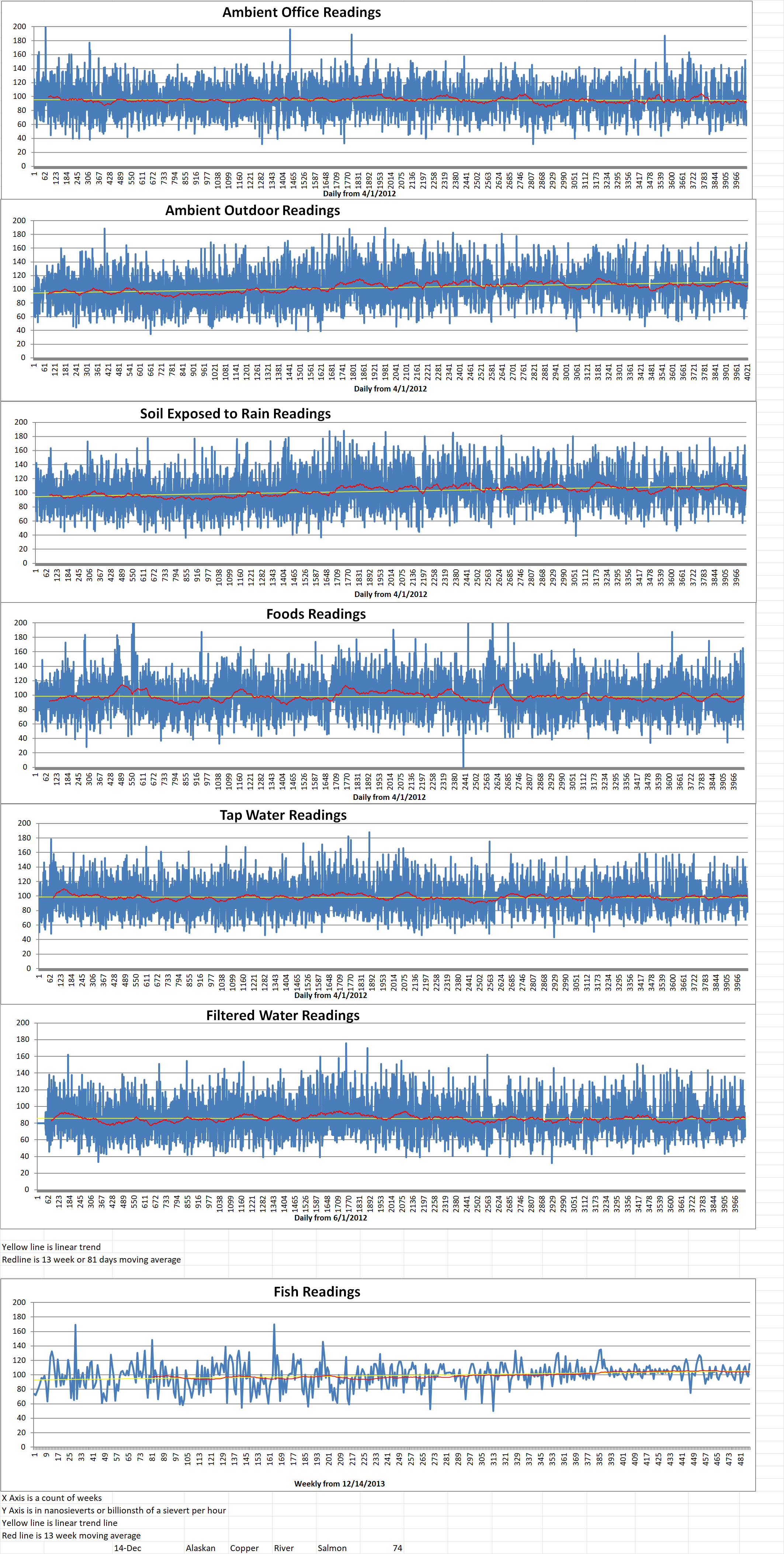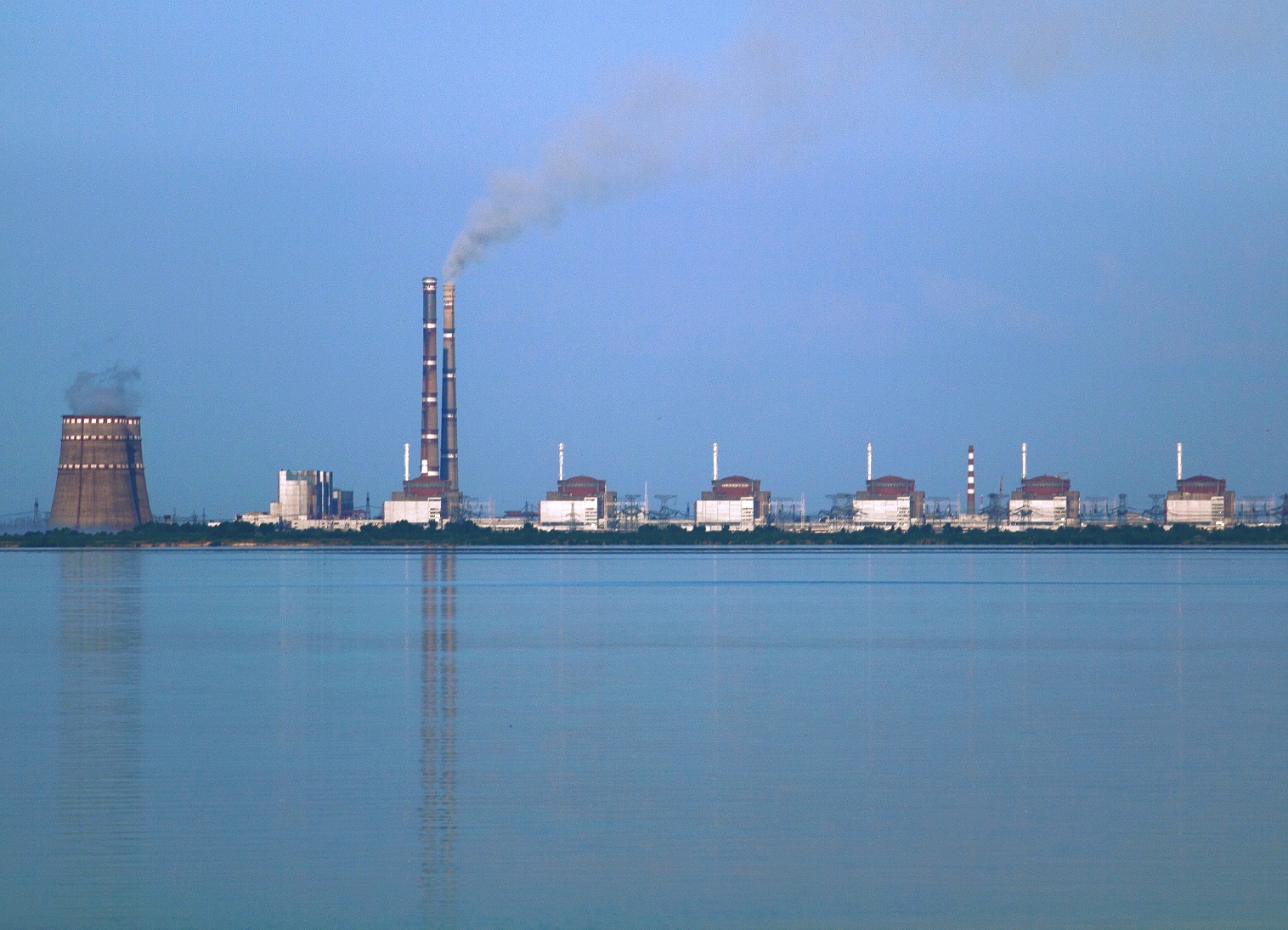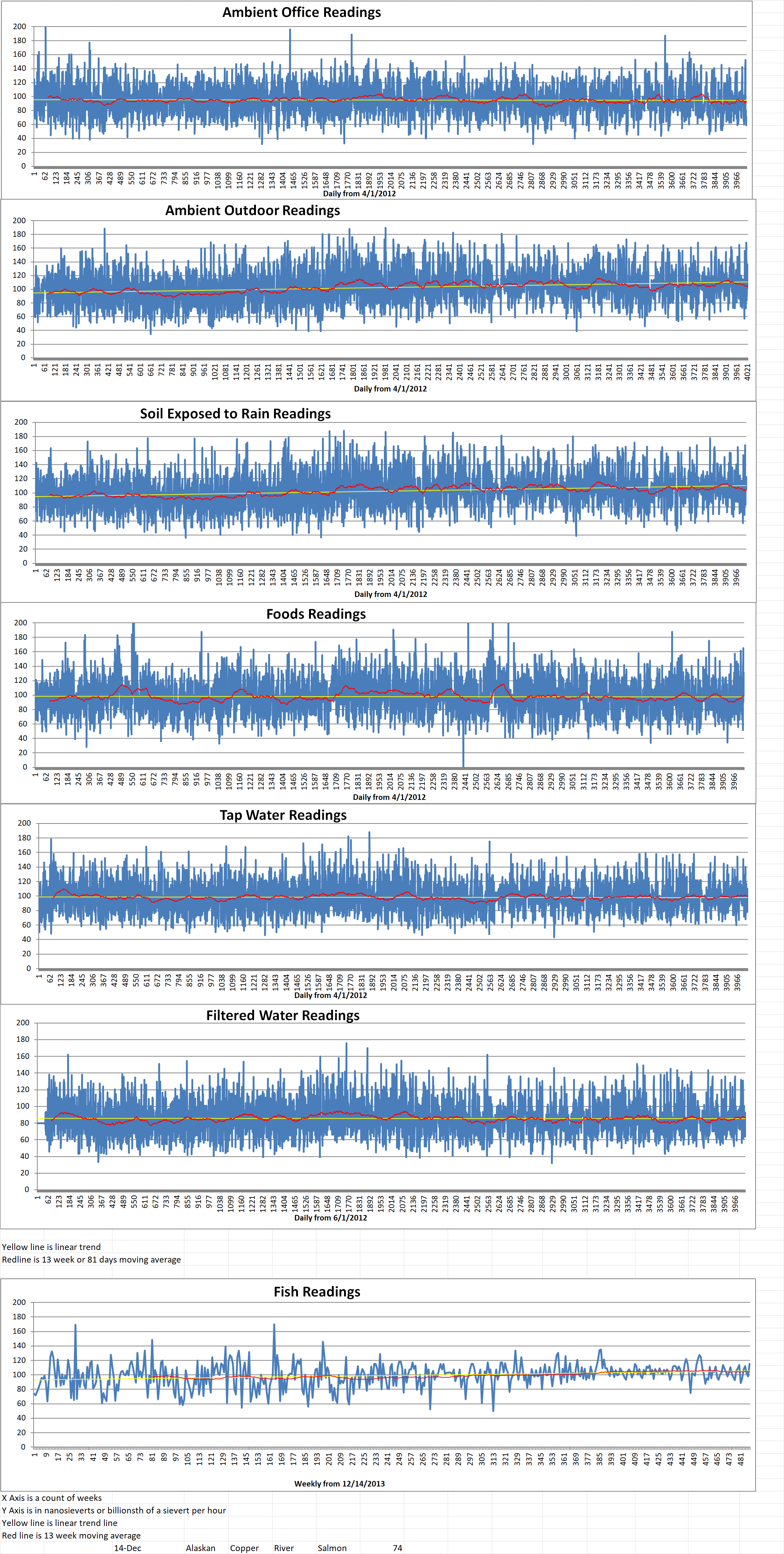Blog
-

Geiger Readings for July 07, 2023
Ambient office = 79 nanosieverts per hour
Ambient outside = 106 nanosieverts per hour
Soil exposed to rain water = 106 nanosieverts per hour
Red bell pepper from Central Market = 143 nanosieverts per hour
Tap water = 91 nanosieverts per hour
Filter water = 72 nanosieverts per hour
-

Nuclear Reactors 1243 – Ukraine Fears That Russia May Deliberately Blow Up The Zaporizizhia Nuclear Power Plant.
Located in southeast Ukraine, Zaporizhzhia is the biggest nuclear power plant in Europe. It normally produces about twenty percent of Ukraine’s electricity. The plant was captured by Russian forces in March of 2022. At the time of its capture, it was feared that the Russian forces would destroy the plant to halt a Ukrainian advance.
Zaporizhzhia has been operational since 1984. It sits on a half square mile site on the banks of the Kakhovka reservoir. Each of the six reactors in the plant is capable of generating one gigawatt. The average nuclear power plant in the U.S. sits on a one square mile site and generates one gigawatt of electricity. Water from the Kakhovka reservoir is critical for the cooling and operation of the plant. Any spent nuclear fuel from the Zaporizhzhia reactors is stored in cooling pools for up to five years to give the residual energy and radioactivity time to decrease so it can be handled.
The Zaporizhzhia plant has multiple safety precautions in place. According to the International Atomic Energy Agency (IAEA), the affects of the Russian attack and occupation have not affected the essential equipment or caused radiation levels to change. U.S. officials have also stated that there is no indication of elevated radiation levels at the plant.
If an explosion occurred at Zaporizhzhia, the results would be catastrophic. Ukrainian officials have said that there is a “real threat of nuclear danger”. Ukrainian foreign minister Dmytro Kuleba warned that if Zaporizhzhia blows up, “it will be 10 times larger than Chernobyl”. The resulting blast would kill thousands of people in the area around the plant. Depending on weather conditions, radiation could be carried further into Europe. Fallout could even reach London. The chances of that are unlikely because the design of the reactors contains many safety features.
The Russian occupying forces have been using Zaporizhzhia as a military base. Vehicles were parked around the reactors. Stocks of supplies and ammunition have also been stored at the plant. There has been fighting between Ukrainian forces and Russian occupiers around Zaporizhzhia. Each side has accused the other of endangering the plant. The Ukrainians fear that the Russians might blow up the plant to deny Ukraine the electricity that it produces. The Russians claim that the Ukrainians might blow up the plant and try to blame the Russians.
Recently, the Russians occupying the plant have been leaving. The Ukrainians have been sounding the alarm that the Russians are placing explosives in and around the plant. They may intend to remotely detonate the explosives after they leave and claim that it was the Ukrainian forces who occupied the abandoned plant who either intentionally or unintentionally caused the plant to explode.
NATO recently passed a resolution that said that if Russia or Russian-aligned nations caused an explosion that spread radioactive materials into NATO nations, then NATO would consider that a nuclear attack by Russia on NATO. Russia might blow up Zaporizhzhia as a last-ditch desperation move, believing they can blame Ukraine and escape retaliation by NATO. The current situation is extremely dangerous. -
Nuclear News Roundup July 06, 2023
Russia Successfully Tests Secret Nuclear-Powered ‘Poseidon’ Torpedo newsweek.com
N Korea slams US move to deploy nuclear submarines to peninsula Aljazeera.com
Trump Administration Officials Were Legitimately Worried About Trump Provoking Nuclear War With North Korea vanityfair.com
Study into deep borehole disposal costs at Krško world-nuclear-news.org
-

Geiger Readings for July 06, 2023
Ambient office = 61 nanosieverts per hour
Ambient outside = 102 nanosieverts per hour
Soil exposed to rain water = 106 nanosieverts per hour
Jalapeno pepper from Central Market = 100 nanosieverts per hour
Tap water = 83 nanosieverts per hour
Filter water = 70 nanosieverts per hour
-

Radioactive Waste 910 – University of Manchester Researchers Find That Some Types Of Bacteria Would Improve Containment Of Nuclear Waste
Certain microbes can use radionuclides such as uranium and neptunium instead of oxygen. In the process, they convert the radionuclides from soluble forms to insoluble forms which makes them less mobile. This should improve our confidence in radioactive waste disposal plans according to Jonathan Lloyd. Lloyd is a geomicrobiologist at the University of Manchester in the U.K. He presented his research at the annual meeting of the Microbiology Society in Edinburgh.
The U.K. has accumulated about six million cubic yards of nuclear waste. This would be enough to fill London’s Wembley stadium four times. Most of it is currently stored in ponds and silos at ground level at Sellafield in Cumbria. The U.K. government plans to dispose of the most highly radioactive waste deep underground in repositories encased in cement. However, the government has yet to select a site for the repository. The plans take into account physical and chemical properties to stop radioactive material from escaping for hundreds of thousands of years. However, biological properties and processes are not included in the planning.
Cement has a pH of about eleven. It has been thought that this would result in alkaline conditions that would make growth of microbes impossible. In order to verify this theory, Lloyds team investigated a lime kiln site in the U.K.’s Peak District in order to see whether microbes could be found growing in conditions similar to those that would be found in a nuclear waste disposal site. He said, “We went to see if there was biology there and there was. We found they could grow at pH values you would probably find developing around these cementitious waste forms. “Radiation levels found at nuclear waste dumps don’t kill these bacteria, they stimulate them.” The radiation levels typically found at nuclear waste dumps do not seem to bother bacteria either. “It does not kill them. If anything, it actually stimulates the microbes.
The study found that the way bacteria process nuclear waste products means that this hazardous material is less likely to leak into the environment. Some nuclear waste contains cellulose. This material can break down to form isosaccharinic acid (ISA) under alkaline conditions. ISA can form a soluble complex with uranium which helps it leak out of a nuclear waste repository. However, bacteria seem to use ISA as a carbon source which keeps radionuclides in a solid form. This means that they remain in the repository.
Microbes may also help prevent radioactive gases from escaping. Hydrogen produced by reactions in the waste repositories can build up pressure and cause them to crack open or explode. However, microbes can consume hydrogen and keep the levels of hydrogen down. They can also grow in fractures in the rock. This process results in the formation of biofilms which clog pores in the rock.
Lloyd said, “At the moment, they have safety case models that are built on chemistry and physical containment. If you start including the biology, it means that those models are actually overly conservative, which is a good thing.” -
Nuclear News Roundup July 05, 2023
US intelligence assessment says Iran not currently developing nuclear weapons timesofisrael.com
Turkey ‘aiming for 20 GW of nuclear by 2050s’ world-nuclear-news.org
Backlash builds as Japan prepares to release wastewater from Fukushima nuclear plant npr.org
Wagner sought nuclear ‘backpacks’ -Ukraine intelligence chief news.yahoo.com
-

Geiger Readings for July 05, 2023
Ambient office = 63 nanosieverts per hour
Ambient outside = 136 nanosieverts per hour
Soil exposed to rain water = 123 nanosieverts per hour
English cucumber from Central Market = 131 nanosieverts per hour
Tap water = 78 nanosieverts per hour
Filter water = 64 nanosieverts per hour
-

Nuclear Weapons 824 – Missing Russian Nuclear Weapons
Before it collapsed in 1991, the Soviet Union (S.U.) manufactured more than twenty-seven thousand nuclear weapons. They also produced more than enough weapons grade uranium and plutonium to make another eighty-one thousand nuclear weapons. The S.U. suffered severe economic distress, widespread corruption, lax security and dependency on the bureaucratic. These factors raise the question of whether some nuclear weapons and/or material may have been lost or stolen from their arsenal.
The former Soviet republics of Belarus, Kazakhstan, and Ukraine were armed with Soviet nuclear weapons. All of these Soviet-era nuclear weapons were returned to post-communist Russia in the 1990s after the fall of the S.U. Fears remain over how the weapons-grade stockpiles of uranium and plutonium could be used. A far greater fear is whether or not all the old S.U. nuclear weapons have been properly accounted for. The International Atomic Energy Agency (IAEA) has reported more than one hundred nuclear smuggling incidents since 1993. Eighteen of those incidents involved highly enriched uranium.
In the late 1990s, Alexander Lebed claimed that the Russian military lost track of over one hundred small Soviet nuclear bombs referred to as “suitcase nukes.” Lebed said that each of these weapons had a yield of one kiloton. They were capable of killing as many as one hundred thousand people. They could be carried and detonated by a single person.
Russia denied Lebed claims. They said that he may have mistaken “dummy small-scale” training devices for actual weapons. In the twenty-four years since Lebed’s report, there have been no verified examples of any Soviet-era suitcase bombs being discovered. Fortunately, no such weapons have been detonated by terrorist organizations.
However, at least two Soviet nuclear weapons have been lost. Both of them are still aboard the Soviet nuclear submarine Komsomolets (K-278) which was put into service in 1984. On April 7th, 1989, the K-278 was operating at a depth of one thousand two hundred and sixty-six feet when a fire broke out. The inexperienced crew was unable to deal with the problem, which was exacerbated by a lack of a dedicated damage control party.
The K-278 was able to surface but the abrupt pressure change caused the top hatch to be blown off. This threw two crewmembers out of the chamber. The K-278 soon sank. In addition to its nuclear reactor, it carried two nuclear armed Shkval torpedoes. Norway pressured the Soviets to find the K-278 and they conducted a deep-sea search. The location of the sunken submarine was discovered in June of 1989.
Between 1989 and 1998, seven expeditions were conducted to secure the reactor against leakages of radioactive materials and to seal the torpedo tubes.
If a terrorist group could obtain a Soviet suitcase bomb, they could destroy a major city anywhere in the world. However, this presupposed that the terrorists had the technical expertise to activate and detonate such a bomb. Even if they did not, they could dismantle the bomb to obtain the radioactive materials it contained to construct a dirty bomb. Dirty bombs just use conventional explosives with a shell of radioactive materials. Distributed over a wide area, the radioactive fallout from such a bomb could render a major city uninhabitable. -
Nuclear News Roundup July 04, 2023
South Korea’s Yoon pushes for strong resolve against North’s nuclear ambitions at NATO summit apnews.com
First Australian Sailors Graduate from Nuclear Power School, Set to Serve on U.S. Navy Subs in Hawaii usni.org
Medvedev threatens to strike three Ukrainian nuclear power plants and nuclear facilities in Europe news.yahoo.com
Pro-nuclear energy EU states ask for ‘level playing field’ with renewables finance.yahoo.com
